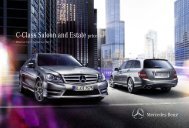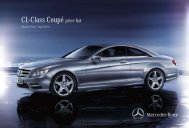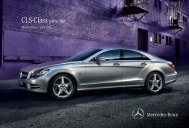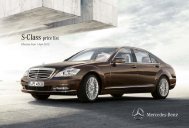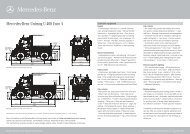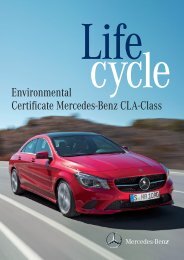Life Cycle - Daimler
Life Cycle - Daimler
Life Cycle - Daimler
You also want an ePaper? Increase the reach of your titles
YUMPU automatically turns print PDFs into web optimized ePapers that Google loves.
<strong>Life</strong>cycleEnvironmental Certificatefor the new CLS1
Product descriptionCultivated sportiness:The new Mercedes-Benz CLSA generation ahead: With the CLS, Mercedes-Benz in2003 created a new category of vehicle, combining forthe first time the elegance and dynamism of a coupe withthe comfort and functionality of a sedan. Customers weredelighted, competitors bewildered: For a number of yearsthe CLS remained the only four-door coupe in its class,and from October 2004 to this day it has been purchasedby some 170,000 customers throughout the world.The engines: Up to 25 percentgreater fuel efficiency, with higher power outputEfficiency at its best: This is the quality shared by allfour engines, which are now being installed for the firsttime in the Mercedes-Benz CLS. These power units are allcharacterized by increased power and torque comparedwith the predecessors, while fuel efficiency has beendrastically boosted by up to 25 percent. At the time of theEuropean launch in January 2011, two six-cylinder modelswill initially be available:CLS 350 CDI BlueEFFICIENCY with 195 kW (265 hp), andCLS 350 BlueEFFICIENCY with 225 kW (306 hp) and theECO start/stop function as standard. Already two monthslater, the engine range will be extended with the additionof the CLS 250 CDI BlueEFFICIENCY developing 150 kW(204 hp).• Positioning: Second generation of the four-door coupefrom the inventor of this segment• Appearance: The new CLS embodiessophisticated sportiness• Drive: Four entirely new engines• Efficiency: Up to 25 percent greater fuel efficiency,ECO start/stop function as standard in almost all versions• World premiere: New generation of the 7G-TRONIC PLUSautomatic transmission as standard in all models• Driving dynamics: New electromechanical direct steering• Light: World premiere for the high-performanceLED headlights• Safety: New driving assistance systems Active Blind SpotAssist and Active Lane Keeping Assist• Comfort: Quieter than ever before• Design: New design icon with sensual contour language• Quality: High-value materials and superb workmanshipOn the ECE consumption cycle, this car makes dowith only 5.1 liters of diesel per 100 km. The CLS 500BlueEFFICIENCY, with a V8 engine and an output of300 kW (408 hp), will follow next April. These twodrive variants also include the ECO start-stop functionas a standard feature.8 9
Lightweight design and aerodynamics:Major contributions to efficiencyIn the new CLS, intelligent lightweight design has madea significant contribution to resolving the traditionalconflict of aims between low weight and high strength.The CLS is the first vehicle from Mercedes-Benz to includeframeless doors in all-aluminum design, comprising deepdrawnaluminum paneling with extruded profiles; theyare around 24 kilograms lighter than conventional steeldoors. The hood, front fenders, trunk lid, parcel shelf, variousbeam profiles, and significant portions of the chassisand engines are also made of aluminum.Aerodynamics likewise makes a significantcontribution to the excellent efficiencyof the new Mercedes-Benz CLS.Although the new model is widerthan its predecessor, thusoffering more frontalarea to the wind, theair resistance hasbeen cut by asmuch as ten percentthanks to thelower drag coefficient,which hasbeen reduced by13 percent to 0.26.Electromechanical direct steering:A new feel for steeringOptimal driving dynamics combined with perfect long-distancedriving comfort – this was the brief in the developmentof the chassis for the new coupe, which is orientedtoward stylish sportiness in design and function. Thesuspension concept, which in the new E-Class has alreadyearned top grades among the trade press and the public atlarge, was therefore reworked all-round and supplementedby a key new engineering element: The new CLS is providingthe basis for the world premiere of electromechanicaldirect steeringThis steering system makes an significantcontribution to the overall efficiencyof the CLS: As the power steering onlyrequires boosting when the steeringwheel is actually turned, fuelsavings of up to 0.3 liters/7 gof CO 2 compared to theprevious model areachieved on the ECEconsumption cycle.As with the E-Class, a three-link front suspension principlewas chosen in a further developed version specificallyfor the new CLS. The principle of the lightweight multilinkindependent rear axle suspended on a subframe wasadopted for the CLS from the new E-Class in view of itsunsurpassed wheel location qualities. Compared to thepredecessor model, all components have been modified forgreater comfort and enhanced driving dynamics.High-performance LED headlights:Improved vision with full functionalityThe CLS is the world’s first automobile to include optionalhigh-performance LED headlights that combine the fascinatingdaylight-like color impression of LED technologywith the performance, functionality, and energy-efficiencyof today’s bi-xenon generation.For the first time, the new headlight system combines theproven Intelligent Light System, already familiar fromMercedes models with bi-xenon headlamps, with LEDtechnology. The headlights, with 71 LEDs in all, have anexciting look and thus underscore the distinctive appearanceof the CLS. The lighting specialists at Mercedes-Benzhave already succeeded for the first time in combiningLED technology with the proven innovative AdaptiveHighbeam Assist, which makes for an entirely new levelof safety in night driving.New driving assistance systems:Greater safetyOver a dozen driving assistance systems in the new CLShelp prevent road accidents or reduce their severity. Newfeatures are Active Blind Spot Assist and Active LaneKeeping AssistActive Blind Spot Assist warns the driver by means ofshort-range radar when it senses danger of collisionduring lane-changing. If the driver ignores the warningsand comes dangerously close to a vehicle in the adjacentlane, Active Blind Spot Assist intervenes. By applying thebrakes on the opposite side of the vehicle via the ElectronicStability Program a yaw movement is generated thatdiverts the vehicle from the collision course.Active Lane Keeping Assist is also networked withESP ® for the first time. The system is activated whenthe Mercedes model unintentionally crosses a solid lineon either edge of the car’s lane. In this case, Active LaneKeeping Assist lightly brakes the opposing wheels withESP ® , to bring the vehicle back on course. A display in theinstrument cluster also alerts the driver. When brokenlane markings are crossed, the system activates an electricalimpulse generator on the steering wheel. This initiatesa brief vibration – a subtle but highly effective indicationto the driver to immediately steer in the opposite direction.This haptic warning in the form of a steering wheelvibration is always provided before the braking action isinitiated.10 11
The new Mercedes-Benz CLS14 15
1 Product documentationThis section documents significant environmentally relevant technical dataof the different variants of the new Mercedes-Benz CLS referred to in the statementson general environmental topics (Chapter 2.1).The detailed analysis of materials (Chapter 1.2), life cycle assessment (Chapter 2.2),and the recycling concept (Chapter 2.3.1) refer to the new CLS 350 BlueEFFICIENCYwith basic equipment.16 17
1.1 Technical data1.2 Material compositionThe following table documents significant technical datafor the variants of the new CLS. The respective environmentally relevantaspects are treated in detail in the Environmental Profile in Chapter 2.The weight and material data for the CLS 350 BlueEFFICIENCY were determined on thebasis of internal documentation of the components used in the vehicle (parts list, drawings).The “curb weight according to DIN” (without driver and luggage, 90 per cent fuel tankfilling) served as a basis for the recycling rate and life cycle assessment. Figure 1-1 shows thematerial composition of the CLS 350 BlueEFFICIENCY in accordance with VDA 231-106.Characteristic CLS 350 CLS 250 CDI CLS 350 CDIBlueEFFICIENCY BlueEFFICIENCY** BlueEFFICIENCYEngine type Gasoline Diesel DieselNo. of cylinders 6 4 6Displacement (effective) [cm3] 3498 2143 2987Power output [kW] 225 150 195Emission standard (fulfilled) EU 5 EU 5 EU 5Weight (w/o driver and luggage) [kg] 1660 1710 1740Exhaust emissions [g/km]CO 2 159-170 134*** 159-166NO X 0.008 n/a 0.148CO 0.067 n/a 0.258HC (gasoline version) 0.049 – –HC+ NOX (diesel version) – n/a. 0.185PM 0.001 n/a 0.001Overall NEDC fuel consumption [l/100 km] 6.8*-7.0 5.1*** 6.0-6.1Driving noise [dB(A)] 73 n/a 72* NEDC consumption for basic variant CLS 350 BlueEFFICIENCY with standard tires: 6.8 l/100 km** Market launch: CLS 250 CDI BlueEFFICIENCY in March 2011 and CLS 500 BlueEFFICIENCY in April 2011*** Provisional NECD value (with standard tires)n/a: Data not yet availableSteel/ferrous materials account for about half the weight(53.5 percent) of the new Mercedes-Benz CLS. These arefollowed by polymer materials (18.6 percent) and thethird-largest group, the light metals (16.3 percent).Service fluids comprise about 4.5 percent. The proportionsof non-ferrous metals and of other materials (especiallyglass) are somewhat lower, at about 2.5 and about 3.6percent respectively. The remaining materials – processpolymers, electronics, and special metals – contributeabout 1 percent to the weight of the vehicle. In this study,the material class of process polymers largely comprisesmaterials for painting.The group of polymer materials is divided into thermoplastics,elastomers, thermosets and non-specific plastics.Thermoplastics account for the largest share of polymers,with 13.7 percent. The second-largest group of polymermaterials are the elastomers, at 3.8 percent (mainly tires).The service fluids include oils, fuels, coolants, refrigerants,brake fluid, and washer fluid. The electronics grouponly comprises circuit boards and their components.Cables and batteries have been allocated according totheir material composition in each particular case. Acomparison with the previous model reveals differencesespecially with regard to steel and aluminum. The newCLS has an approximately 3 percent lower steel content ataround 53.5 percent, while the proportion of light metals,at 16.3 percent, is 2 percent higher than in the predecessormodel. The share of polymer materials has risen byalmost 1 percent to 18.6 percent. The main constructionaldifferences are as follows:• Increased use of high-strength steel in the bodyshellfor increased crash safety.• Use of aluminum for the doors, fenders, and trunk lid.• Rear axle with a higher proportionof high-strength steel• New engine with spray-guided direct injection andsignificantly enhanced fuel economy.Light metals 16.3 %2.5 % Non-ferrous metals0.01 % Special metals0.8 % Process polymers3.6 % Other0.2 % Electronics4.5 % Service fluids13.7 % ThermoplasticsSteel and ferrousmaterials 53.5 %18.6 % Polymer materials3.8 % Elastomers/elastomer composites0.1 % Duromers1.0 % Other plasticsFig 1-1: Material composition of the CLS 350 BlueEFFICIENCY18 19
2 Environmental profileThe environmental profile documents the general environmentalfeatures of the new CLS with regard to such matters as fuel efficiency,emissions, and environmental management systems, as well as providingspecific analyses of the environmental performance, such as life cycleassessment, the recycling concept, and the use of secondary andrenewable materials.20 21
2.1 General environmental topics• With an average consumption of 6.8 l/100 km, theCLS 350 BlueEFFICIENCY is up to 33 percent moreeconomical than its predecessor, despite the 10 kWincrease in maximum output• The CLS 250 CDI BlueEFFICIENCY makes do with anaverage of 5.1 liters per 100 km, corresponding toCO 2 emissions of 134 g/km• BlueEFFICIENCY technology optimizes e.g.aerodynamics, rolling resistance, vehicle weight,and energy management• Since 1996, the CLS production plant in Sindelfingenhas had a certified environmental management systemin accordance with the EMAS regulations of the EU andthe ISO 14001 standard• Effective recycling system and high environmentalstandards also at dealershipsThe fuel efficiency benefits are ensured by an intelligentpackage of measures, the so-called BlueEFFICIENCYtechnologies. These extend to optimization measures inthe power train, energy management, and aerodynamics,and to tires with optimized rolling resistance, weightreduction through lightweight design, and driver informationon energy-efficient driving. The illustration on pages24/25 shows the measures implemented in the new CLSin detail.In addition to improvements to the vehicle, the driveralso has a decisive influence on fuel efficiency. For thisreason, a display in the middle of the speedometer showsThe new Mercedes-Benz CLS makes for significantlythe current fuel consumption level. This easily readableimproved fuel efficiency. In the CLS 350 BlueEFFICIENCYbar indicator reacts immediately when the driver takesgasoline model, consumption has now decreased from thehis or her foot off the accelerator, for example, and makesprevious levels of 10.1 l/100 km (on market entry in 2004)use of the fuel cut-off on the overrun. The owner’s manualand 9.1– 9.3 l/100 km (market exit in 2010) to 6. 8–7.0 l/of the new CLS also includes hints on an economical and100 km, depending on the tires used. In comparison to theenvironment-friendly driving style. Furthermore,time of launch of its predecessor, this represents a considerablereduction in fuel consumption by up to 33 percent;the findings from this training course show that a car’sMercedes-Benz offers its customers “Eco Driver Training”;and in comparison with the market exit of the predecessorfuel efficiency can be increased by up to 15 percent bymodel, the reductions amount to as much as 25 percent.means of economical and energy-conscious driving.The improvements in the diesel are no less impressive:The new CLS 350 CDI BlueEFFICIENCY consumesThe new CLS is also fit for the future in terms of fuels.6.0–6.1 l/100 km (depending on tires), about 21 percentThe EU’s plans provide for an increasing share of biofuels.less fuel than the previous top diesel model. The four-This requirement is already fulfilled by the CLS, since acylinder CLS 250 CDI BlueEFFICIENCY diesel enginebioethanol content of 10 percent (E10) is permissible forwith 150 kW/204 hp, available in the CLS for the firstgasoline engines. A 10 percent share of biofuels is also allowedfor diesel engines, in the form of 7 percent biodieseltime, achieves an average fuel consumption of 5.1 l/100 km (134 g CO 2 /km). 1 (B7 FAME) and 3 percent of high-quality hydrogenatedvegetable oil. The diesel models can also run on SunDiesel,in the development of which Mercedes-Benz is playing adecisive role. SunDiesel is elaborately liquefied biomass.The advantages of this fuel over conventional fossil dieselare its almost 90 percent lower CO 2 emissions; it alsocontains neither sulfur nor noxious aromatics. The propertiesof this clean, synthetic fuel can be practically made tomeasure in production and optimally attuned to a specificengine. However, the greatest advantage is that it makesfull use of the biomass. Unlike conventional biodiesel,for which only about 27 percent of the energy containedin rapeseed is converted into fuel, the process employedby CHOREN utilizes not only the oil seed, but the wholeplant.Significant improvements have also been achieved interms of exhaust emissions. Mercedes-Benz is the world’sfirst automobile manufacturer to install maintenance- andadditive-free diesel particulate filters into all diesel cars,from the A- to the S-Class. 2 This of course also applies tothe diesel variants of the new CLS.With the new CLS, Mercedes-Benz is considerably reducingnot only particulates, but also other emissions. TheCLS 350 BlueEFFICIENCY, for example, has a nitrogenoxide (NO x ) emission level 79 percent below that of thecomparable predecessor model; the emissions of hydrocarbons(THC) and carbon monoxide (CO) have likewise beenreduced by 28 percent and 14 percent respectively.1Provisional NEDC value (with standard tires)2A standard feature in Germany, Austria, Switzerland, and the Netherlands; optional in all other countries with a fuel sulfur content of less than 50 ppm.22 23
Four new engines:CLS 250 CDI BlueEFFICIENCYCLS 350 CDI BlueEFFICIENCYCLS 350 BlueEFFICIENCYCLS 500 BlueEFFICIENCYConsumption-optimized 7G-TRONIC PLUS automatic transmissionECO start/stop functionLightweight design concept[Doors, hood, trunk lid, front fenders of aluminum]Generator managementClutchRefrigerant compressorElectromechanical direct steeringThe CLS is produced at the Sindelfingen plant, whichsince 1996 has operated with an environmental managementsystem certified in accordance with the EMASregulations of the EU and the ISO 14001 standard. Aparticular focus of activity is the ongoing improvement ofresource and energy efficiency. The objective is to reduceenergy consumption by 20 percent per vehicle by the year2012, by means of various technical and organizationalmeasures. In addition to measures such as shutting off robotsduring breaks in bodyshell manufacture, or standbyoperation of laser units for the S-Class, the employeesthemselves are motivated to save energy. Several energyefficiency measures are being implemented, above all inpainting. Of particular note are the optimum use of existingmaterial processing windows for the coating materialswith regard to temperature and humidity, process-optimizedadaptation of air management in the spray booth,and energy-optimized control of the system’s operatingtimes. This has already led to annual savings of about21,000 megawatt-hours, and energy costs have also beenconsiderably reduced.In sales and after-sales, too, high ecological standards aresecured in Mercedes-Benz’s own environmental managementsystems. At the dealerships, Mercedes-Benz fulfillsits product responsibility with the MeRSy recyclingsystem for workshop waste and for vehicle, used, andwarranty parts and packaging material. With the takebacksystem introduced in 1993, Mercedes-Benz has alsoenjoyed a position as role model within the automotiveindustry in workshop disposal and recycling.This exemplary performance in automotive manufactureis consistently applied throughout the process, rightup to the customer. The waste that accumulates at theworkshops resulting from the maintenance and repair ofMercedes vehicles is collected via a nationally organizednetwork, processed, and made available for reuse. The“classics” include bumpers, side panels, electronic scrap,glass, and tires. The chlorine-free refrigerant R134a forthe air conditioning system, which does not contribute toozone depletion in the stratosphere, is also disposed ofappropriately in view of its contribution to the greenhousepotential.Aerodynamic optimization[Exterior mirrors, radiator grille,aerowheel inCLS 250 CDI BlueEFFICIENCY]Tires with optimizedrolling resistanceThe reuse of used parts also has a long tradition atMercedes-Benz. The Mercedes-Benz Used Parts Center(GTC) was established back in 1996. With its qualitytestedparts, the GTC is an integral element of service andparts operations for the Mercedes-Benz brand. Althoughthe reuse of Mercedes passenger cars lies in the distantfuture in view of their long service life, Mercedes-Benzoffers a new, innovative procedure for the rapid disposalof vehicles in an environment-friendly manner and free ofcharge.Fig 2-1: Fuel efficiency measures in the new CLSFor convenient disposal, a comprehensive network ofcollection points and dismantling facilities is availableto Mercedes customers. Owners of used cars can informthemselves of all important details relating to the returnof their vehicles at the toll-free number 00800 1 777 7777.24 25
2.2 <strong>Life</strong> cycle assessment (LCA)Decisive for the environmental compatibility of a vehicle is the environmental impactof its emissions and consumption of resources throughout its life cycle (see Figure 2-2).The standardized tool for assessing a vehicle’s environmental impact is life cycle assessment (LCA).This shows the total environmental impact of a vehicle from the cradle to the grave, in other wordsfrom raw material extraction through production and usage up to recycling.With life cycle assessment, Mercedes-Benz registers all theeffects of a vehicle on the environment - from productionthrough to operation and disposal• For a comprehensive assessment, all environmentalinputs are accounted for within each phase of the life cycle• Many emissions arise not so much during driving,but in the course of fuel production – for example theemissions of hydrocarbons (non-methane volatile organiccompounds, NMVOC) and sulfur dioxide• The detailed analysis also includes the consumptionand processing of bauxite (aluminum production),iron and copper oreIn the development of Mercedes-Benz passenger cars,life cycle assessments are used in the evaluation andcomparison of different vehicles, components, and technologies.The DIN EN ISO 14040 and DIN EN ISO 14044standards prescribe the procedure and the requiredelements.The elements of a life cycle assessment are:1. The investigative terms of referencedefine the objective and scope of an LCA.2. <strong>Life</strong> cycle inventoryencompasses the material and energy flowsthroughout all stages of a vehicle’s life:how many kilograms of raw material are used,how much energy is consumed,what wastes and emissions are produced, etc.3. Impact assessmentFigure 2-2: Overview of <strong>Life</strong> <strong>Cycle</strong> Assessmentgauges the potential effects of the product onhumans and the environment, such as globalwarming potential, summer smog potential,acidification potential, and eutrophicationpotential.4. Evaluationdraws conclusions and makesrecommendations.26 27
2.2.1 Data basisTo be able to ensure the comparability of the vehicles, as a rule the basic ECE basis variantwas investigated. The CLS 350 BlueEFFICIENCY (225 kW) at the time of launch served asthe basis variant for the new CLS; the corresponding predecessor (at the time of market exitand market entry) served as a basis of comparison.A comparison with these two variants allows the steps in development already completedin the predecessor up to the time of market exit to be determined. These document theongoing improvement of environmental performance over the lifetime of a model generation.In the following, the essential basic conditions for the LCA are presented in a table.Project objectiveProject objective• LCA for the new CLS as basic ECE variant with the CLS 350 BlueEFFICIENCY engine,in comparison with its predecessor.• Verification of goal attainment for “environmental compatibility” and communicationProject scopeFunctional equivalent • Mercedes-Benz CLS passenger car (basic variant; weight in acc. with DIN 70020)Technological/• With two generations of one vehicle type, the products are fundamentally comparable. Due to continuing developmentsproduct comparability and changing market requirements, the new CLS provides additional features, above all in passive and active safetyand – to a certain extent – in terms of a higher output. In cases where these additional features have an influence on theanalysis, a comment is provided in the course of evaluation.System bounds• <strong>Life</strong> cycle assessment for car manufacture, use, disposal/recycling. The system boundaries should only be exceeded byelementary flows (resources, emissions, dumping/deposits)Basis of data • Passenger car weight data: MB parts lists (as at: 04/2010).• Materials information on model-relevant vehicle-specific parts: MB parts list, MB internal documentationsystems, technical literature.• Vehicle-specific model parameters (bodyshell, paintwork, catalytic converter etc.): MB specialist departments.• Site-specific energy provision: MB database.• Materials information for standard components: MB database.• Use (consumption, emissions): type approval/certification data. Use (mileage): determined by MB.• Recycling model: in acc. with latest technology (see also Chapter 2.3.1).• Material production, energy supply, manufacturing processes, and transport: GaBi database, status: SP14(http://documentation.gabi-software.com); MB database.Allocations• For material production, energy supply, manufacturing processes, and transport, reference is made to GaBi databasesand the allocation methods they employ.• No further specific allocations.Project scope(continued)Cut-off criteria• For material production, energy supply, manufacturing processes, and transport, reference is made to GaBi databases andthe cut-off criteria they employ.• No explicit cut-off criterion. All available weight data are processed.• Noise and land use are not currently available in LCA data and are therefore not taken into account.• Fine dust and particulate emissions are not considered. Major sources of fine dust (above all from tires and brakes) areindependent of vehicle type and are thus not relevant to the vehicle comparison.• Vehicle care and maintenance are not relevant to the comparison.Assessment• <strong>Life</strong> cycle, in acc. with ISO 14040 and 14044 (product LCA).Analysis parameters • Material composition in acc. with VDA 231-106.• <strong>Life</strong> cycle inventory level: consumption of resources as primary energy; emissions, e.g. CO 2 , CO, NO X , SO 2 , NMVOC, CH 4 .• Impact assessment: abiotic depletion potential (ADP), global warming potential (GWP), photochemical ozonecreation potential (POCP), eutrophication potential (EP), acidification potential (AP).These impact assessment parameters are based on internationally accepted methods. They are based on the categoriesselected by the European automotive industry, with the participation of numerous stakeholders, as part of the EU’s LIRECARproject. Representation of toxicity potential for humans and the environment would be imprecise according to the currentstate of the art and is therefore not expedient.• Interpretation: sensitivity studies of car module structure; dominance analysis of life cycle.Software support• MB DfE tool. This tool presents a passenger car on the basis of the typical structure and components, including theirproduction, and is adapted by means of vehicle-specific data on materials and weight. It is based on the assessmentsoftware GaBi4.3 (http://www.pe-international.com/gabi).Evaluation• Analysis of the life cycle results according to phases (dominance). The manufacturing phase is evaluated on the basis of theunderlying passenger car module structure. Contributions relevant to the analysis are discussed.Documentation• Final report with all basic conditions.Table 2-1: Basic conditions for LCAThe fuel has a sulfur content taken to be 10 ppm.Combustion of one kilogram of fuel thus yields 0.02 gramsof sulfur dioxide emissions. The usage phase is calculatedon the basis of a mileage of 250,000 kilometers.The LCA includes the environmental impact of thedisposal phase on the basis of the standard processes ofdrying, shredding, and recovery of energy from the lightshredder fraction. Environmental credits are not granted.28 29
2.2.2 LCA results for the CLS 350 BlueEFFICIENCYCar production Fuel production Operation RecyclingPOCP [kg ethylene equiv.]13ADP [kg Sb equiv.]36950EP [kg phosphate equiv.]9,54047.4AP [kg SO 2 -equiv.]84CO2-emissions [t/car]30201009.20.5Production Use RecyclingGWP100 [t CO 2 -equiv.]CH 4 [kg]SO 2 [kg]NMVOC [kg]NO X [kg]6090542530Over the entire life cycle of the CLS 350 BlueEFFICIENCY,the LCI analysis yields for example a primary energy consumptionof 820 gigajoules (corresponding to the energycontent of around 25,000 liters of premium gasoline),an environmental input of approx. 57 tonnes of carbondioxide (CO 2 ), around 25 kilograms of non-methanevolatile organic compounds(NMVOC), around 30kilograms of nitrogenoxides (NO X ) and 54kilograms of sulfurdioxide (SO 2 ). In addition toan analysis of the overall results, the distributionof individual environmental factors on the variousphases of the life cycle is investigated. The relevance ofthe respective life cycle phases depends on the particularenvironmental impact under consideration. For CO 2emissions, and likewise for primary energy consumption,the use phase dominates with a share of 79 percent (seeFigure 2-3).Figure 2-3: Overall carbon dioxide (CO 2 ) emissions in tonnesHowever, the use of a vehicle is not alone decisive for itsenvironmental impact. A number of environmental emissionsarise to a significant extent in manufacture, e.g. SO 2and NO X emissions (see Figure 2-4). The production phasemust therefore be included in the analysis of ecologicalcompatibility. Not actual driving operation, but rather fuelproduction is now the dominantfactor for a variety of emissions,such as hydrocarbon(NMVOC) and (NO X , and forclosely associated environmentaleffects such as photochemicalozone creation potential (POCP,summer smog) and acidification potential (AP).CO [kg]Primary energyrequirement [GJ]CO 2 [t]Figure 2-4: Share of life cycle stages for selected parameters0 % 10 % 20 % 30 % 40 % 50 % 60 % 70 % 80 % 90 % 100 %For comprehensive and thus sustainable improvementof the environmental impacts associated with a vehicle,the end-of-life phase must also be considered. The use orinitiation of recycling systems is worthwhile from an energeticpoint of view. For a comprehensive assessment, allenvironmental inputs are taken into consideration withineach phase of the life cycle. In addition to the resultsshown above, it was determined for example that municipalwaste and stockpile goods (especially ore processingresidues and tailings) largely arise in the manufacturingphase, while special waste is created mainly in the manufactureof gasoline in the use phase.Environmental burden in the form of emissions into wateris a result of vehicle manufacture; this especially appliesto heavy metals, NO 3 - and SO 42--ions, and the factors AOX,BOD, and COD.In order to assess the relevance of environmental factors,the impact categories abiotic depletion potential (ADP),eutrophication potential (EP), photochemical ozone creationpotential (POCP, summer smog), global warming potential(GWP), and acidification potential (AP) are shownin normalized form for the life cycle of theCLS 350 BlueEFFICIENCY.598205730 31
1,60 E-091,20 E-09 Recycling Use ProductionTotal vehicle (paintwork)Passanger cell/body shellFlaps/wings8,00 E-104,00 E-100,0 E+00DoorsCockpitMounted external partsMounted internal partsCO 2SO 2New CLS production overall:CO 2 9.2 tSO 2 26.7 kgADP EP POCP GWP APFigure 2-5: Normalized life cycle for the CLS 350 BlueEFFICIENCY [-/passenger car]Seat unitElectrics/electronicsDrivetrainIn normalization the life cycle is evaluated against asuperordinate reference system for improved understandingof the significance of each indicator value. The frameof reference chosen was Europe (EU25 +3). Normalizationwas based on the overall European yearly values, and thelife cycle of the CLS 350 BlueEFFICIENCY was itemizedfor one year.In terms of European yearly values, ADP accounts for thelargest share in the CLS 350 BlueEFFICIENCY, followed byGWP (see Figure 2-5).The relevance of these two impact categories on the basisof EU25 +3 is therefore greater than that of the remainingimpact categories examined. The proportion is the lowestin eutrophication.In addition to the analysis of overall results, the distributionof selected environmental effects on the productionof individual modules is investigated. Figure 2-6 shows byway of example the percentage distribution of carbon dioxideand sulfur dioxide emissions for different modules.While bodyshell manufacture is predominant in carbondioxide emissions, in terms of sulfur dioxide it is moduleswith precious and nonferrous metals and glass that are ofgreater relevance, since these give rise to high emissionsof sulfur dioxide in material production.TiresControlsFuel systemHydraulicsEngine/transmission peripheryEngineTransmissionSteeringFront axleRear axle0 % 5 % 10% 15 % 20 % 25% 30 %Emissions in car manufacture [%]Figure 2-6: Distribution of selected parameters (CO 2 and SO 2 ) to modules32 33
2.2.3 Comparison with the predecessor modelIn parallel with the analysis of the new CLS, an assessmentof the ECE basic version of the predecessor modelwas made (1,660 kg DIN weight on market exit, 1,655kg DIN weight on market entry). The underlying conditionswere identical to those for the new CLS model. Theproduction process was represented on the basis of anexcerpt from the current list of parts. Use of the predecessorvehicle with a comparable engine was calculated onthe basis of applicable certification values. The same stateof-the-artmodel was used for recovery and recycling.As Figure 2-7 shows, the two vehicle models are characterizedby similar levels of carbon dioxide emissions inproduction. Assessment of the entire life cycle yields clearadvantages for the new Mercedes-Benz CLS.At the beginning of the life cycle, production of the newCLS gives rise to about the same amount of CO 2 emissionsas its predecessor (9.2 tons of CO 2 overall). In the subsequentusage phase the new CLS emits around 47 tonnesof CO 2 ; the total emissions during production, use, andrecycling thus amount to 57 tons of CO 2 .The following savings have been achieved over the predecessormodel on its introduction in 2004:• A 30 percent reduction in CO 2 emissions over the entirelife cycle• A 21 percent reduction in nitrogen oxide emissions• A 27 percent reduction in primary energy demand overthe entire life cycle, corresponding to the energy contentof 9,300 liters of gasolineProduction of the previous model at the time of marketexit (= predecessor from 2010) gives rise to 9.5 tonnes ofCO 2 . The figure for the predecessor from 2004 is slightlymore favorable, with 9.1 tonnes of CO 2 . This is mainlydue to the quantity of precious metals used in exhaustgas aftertreatment, which was lower at that time. Dueto the higher fuel consumption, the predecessor emits72 tonnes (2004) and 65 (2010) tonnes of CO 2 duringuse phase. The overall figures are therefore about 81 and74 tonnes of CO 2 emissions.Over its entire life cycle, comprising production, operationover 250,000 kilometers, and recycling, the new modelgives rise to 23 percent (17 tonnes) less CO 2 emissionsthan its predecessor on market exit. If the model onmarket entry is used as a basis of comparison, the newCLS is 30 percent (24 tonnes) more favorable.This reduction in CO 2 emissions is relevant.The savings of about 24 tonnes per vehicle is about2.4 times the annual per-capita emissions due to anaverage European. 3CO2-emissions [t/car]Carproduction90807060504030201000.539.87.6Fuelproduction Operation Recycling0.554.30.560.310.2 11.39.2 9.5 9.1NewCLSPredecessorfrom 2010New CLSPredecessorfrom 2004159 g CO 2 /kmPredecessor from 2010 217 g CO 2 /kmPredecessor from 2004 241 g CO 2 /kmAs at: 08/20103European Environment Agency: EAA Report 09/2009,Greenhouse gas emission trends and projections in Europe 2009.Figure 2-7: Carbon dioxide emissions of the CLS 350 BlueEFFICIENCYin comparison with the predecessor [t/car]34 35
2.3 Design for recoveryWith the adoption of the European ELV Directive (2000/53/EC)on September 18, 2000 the conditions for recovery of end-of-life vehicles were revised.The objective of this directive is the prevention ofvehicle waste and the promotion of the return, reuse,and recycling of vehicles and their components. Thisresults in the following requirements on the automotiveindustry:• Establishment of systems for collection of end-of-lifevehicles (ELVs) and used parts from repairs.• Achievement of an overall recovery rate of 95 percentby weight by January 1, 2015 at the latest• Evidence of compliance with the recovery rate in typeapproval for new passenger cars as of December 2008.• Take-back of all ELVs free of charge from January 2007.• Provision of dismantling information from themanufacturer to the ELV recyclers within six monthsof market introduction.• Prohibition of the heavy metals lead, hexavalentchromium, mercury, and cadmium, taking into accountthe exceptions in Annex II.The CLS already meets the recovery rate of 95 percent byweight, effective January 1, 2015• End-of-life vehicles have been taken back byMercedes-Benz free of charge since January 2007• Heavy metals such as lead, hexavalent chromium,mercury, and cadmium have been eliminated in accordancewith the requirements of the ELV Directive• Mercedes-Benz already today has a highly efficienttake-back and recycling network• By reselling certified used parts, the Mercedes UsedParts Center makes an important contribution to therecycling concept• Even during development of the CLS, attention was paidto separation of materials and ease of dismantling ofrelevant thermoplastic components such as bumpers,wheel arches, outer sills, underfloor paneling, and enginecompartment coverings• Detailed information is provided in electronic form forall ELV recyclers: the International DismantlingInformation System (IDIS)40 41
2.3.1 Recycling concept for the new Mercedes-Benz CLSThe calculation procedure is regulated in ISO standard 22628,“Road vehicles – Recyclability and recoverability – calculation method.”The calculation model reflects the real ELV recyclingprocess and is divided into four stages:1. Pre-treatment (extraction of all service fluids, removalof tires, battery, and catalytic converter, triggering ofairbags2. Dismantling (removal of replacement parts and/orcomponents for material recycling)3. Segregation of metals in the shredder process4. Treatment of non-metallic residue fraction (shredderlight fraction, SLF).The recycling concept for the new CLS was devised inparallel with development of the vehicle; the individualcomponents and materials were analyzed for each stageof the process. The volume flow rates established for eachstage together yield the recycling and recovery rates forthe entire vehicle.At the ELV recycler’s premises the fluids, battery, oil filter,tires, and catalytic converters are removed as part of thepre-treatment process. The airbags are deployed with adevice that is standardized among all European car manufacturers.During dismantling, the prescribed parts arefirst removed according to the European ELV Directive. Toimprove recycling, numerous components and assembliesare then removed and are sold directly as used spare partsor serve as a basis for the manufacture of replacementparts.The reuse of parts has a long tradition at Mercedes-Benz.The Mercedes-Benz Used Parts Center (GTC) was establishedback in 1996. With its quality-tested used parts,the GTC is an integral part of the Mercedes-Benz brand’sservice and parts business and makes an important contributionto the appropriately priced repair of our vehicles.In addition to the used parts, materials are selectivelyremoved in the vehicle dismantling process that can berecycled using economically appropriate procedures.These include components of aluminum and copperas well as selected large plastic components.Vehicle mass: m VPre-treatment: m PFluidsBatteryTiresAirbagsCatalytic convertersOil filterELV recyclerR cyc= (m P+m D+m M+m Tr)/m Vx 100 > 85 percentR cov= R cyc+ m Te/m Vx 100 > 95 percentFigure 2-11: Material flows in the Mercedes-Benz CLS recycling conceptDismantling: m DPrescribed parts 1 ),Components forrecoveryand recyclingDuring the development of the new CLS, these componentswere specifically designed for subsequent recycling.Along with segregated separation of materials, attentionwas also given to ease of dismantling of relevant thermoplasticcomponents such as bumpers, wheel arch linings,outer sills, underfloor paneling and engine compartmentcoverings. In addition, all plastic parts are marked in accordancewith international nomenclature.Segregationof metals: m MResidual metalShredder operatorsSLF 2 ) treatmentm Tr= recyclingm Te= energy recovery1) in acc. with 2000/53/EC2) SLF = shredder light fractionIn the subsequent shredding of the residual body shell,the metals are first separated for recycling in the rawmaterial production processes. The largely organicremaining portion is separated into different fractionsfor environment-friendly reprocessing in raw materialor energy recovery processes. With the described processchain, a recyclability rate of 85 percent and a recoverabilityrate of 95 percent were verified on the basis of theISO 22628 calculation model for the new CLS as part ofthe vehicle type approval process (see Figure 2-11).42 43
2.3.2 Dismantling information2.3.3 Avoidance of potentially hazardous materialsDismantling information for ELV recyclers plays an importantrole in implementation of the recycling concept.The avoidance of hazardoussubstances is a matter of toppriority in the development,production, use, and recyclingof Mercedes vehicles. For theprotection of humans and theenvironment, substances andsubstance classes that may bepresent in materials or componentsof Mercedes-Benz passengercars have been listed in the internal standard (DBL8585) since 1996. This standard is already made availableto the designers and materials experts at the advanceddevelopment stage for both the selection ofmaterials and the definition of manufacturing processes.The new CLS complies with valid regulations. For example,lead-free elastomers are used in the drivetrain, alongwith lead-free pyrotechnic initiators, cadmium-free thickfilm pastes, and surfaces free of hexavalent chromium inthe interior, exterior, and assemblies.Figure 2-12: Screenshot of the IDIS softwareDismantling information for ELV recyclers plays an importantrole in implementation of the recycling concept. Forthe new CLS too, all necessary information is provided inelectronic form via the International Dismantling InformationSystem (IDIS). The IDIS software provides the ELVrecyclers with information, on the basis of which vehiclescan be subjected to environment-friendly pre-treatmentand recycling techniques at the end of their service life.The system presents model-specific data both graphicallyand in text form. In pre-treatment, specific information isprovided on service fluids and pyrotechnic components. Inthe other areas, material-specific information is providedfor the identification of non-metallic components. Thecurrent version (April 2010) covers 1,530 different modelsand variants from 60 car brands. The IDIS data are madeavailable to ELV recyclers and incorporated into the softwarehalf a year after the respective market launch.The heavy metals lead, cadmium, mercury, and hexavalentchromium, which are prohibited by the ELV Directiveof the EU, are also taken into consideration. To ensurecompliance with the ban on heavy metals in accordancewith the legal requirements, Mercedes-Benz has modifiedand adapted numerous processes and requirements bothinternally and with suppliers.Materials used for components in the passenger compartmentand boot are subject to additional emission limitsthat are likewise laid down in the DBL 8585 standard aswell as in delivery conditions for the various components.The continual reduction of interior emissions is a majoraspect of component and material development forMercedes-Benz vehicles.44 45
2.4 Use of secondary raw materialsIn the CLS, 61 components with a total weight of 49 kgcan be produced partly from high-quality recycled plastics• These include wheel arch linings, cable ducts, and underbody panels• The mass of the recyclate components has risen by96 percent as compared with the predecessor modelFigure 2-13: Example of the use of recycled materials in the wheel arch liningsFigure 2-14: Use of recycled materials in the new CLS• Wherever possible, recyclate materials are derived fromvehicle-related waste streams; the front wheel arches aremade from recovered vehicle componentsIn addition to the requirements for attainment ofrecycling rates, the manufacturers are obliged byArticle 4, Paragraph 1 (c) of the European ELV Directive2000/53/EC to make increased use of recycled materialsin vehicle production and thereby to establish or extendthe markets for secondary raw materials. To meet theserequirements, the technical specifications for new Mercedesmodels prescribe a constant increase in the recycledcontent of passenger cars.The studies relating to the use of recycled material,which accompany the development process, focus onthermoplastics. Unlike steel and ferrous materials, whichalready include a proportion of secondary materials fromthe outset, the use of plastics requires a separate procedurefor the testing and release of the recycled materialfor each component. For this reason, the data on the useof recycled material in passenger cars are documentedonly for thermoplastic components, as this is the onlyfactor that can be influenced in the course of development.The quality and functionality requirements placed on acomponent must be met both with recyclates and withcomparable new materials. To secure passenger carproduction even when shortages are encountered on therecycled materials market, new material may also be usedas an option.In the new CLS, a total of 61 components with an overallweight of 49 kg can be manufactured partly fromhigh-quality recycled plastics. The mass of the approvedcomponents made from recycled material has thus beenincreased by 96 percent as compared with the previousmodel. Typical applications include wheel arch linings,cable ducts, trunk linings, and underbody panels, whichare largely made from polypropylene. Further materialcycles have also been closed in the new CLS: The use ofrecycled acrylonitrile butadiene styrene (ABS), for example,has been approved for the base support of the centerconsole in this vehicle’s interior. Figure 2-14 shows thecomponents approved for the use of recycled material.A further objective is to derive the recycled materials asfar as possible from automotive waste streams, therebyclosing process loops. For the front wheel arch linings ofthe CLS, for example, a recyclate is used that is composedof reprocessed vehicle components (see Figure 2-14);these comprise starter battery casings, bumper coversfrom the Mercedes-Benz recycling system, and processwaste from cockpit production.Component weight New CLS Predecessorin kg 49 25 + 96 %46 47
2.5 Use of renewable raw materials• 56 components with a total weight of almost31 kilograms are produced using natural materials• The floor in the trunk consists of a cardboardhoneycomb structure• Coke is used in the activated charcoal tank vent filter• The textile portion of the fabric/leather combinationconsists of about 30 percent pure lambswool• The door panels employ a natural fiber blend of flax,sisal, and kenafIn automotive production, the use of renewable rawmaterials concentrates on the vehicle interior. In the newCLS, the natural fibers largely comprise leather, cellulose,cotton, flax, sisal, kenaf, and wool, which are usedin combination with various polymer materials for seriesproduction. The use of natural materials in automotivemanufacture has a number of advantages:• In comparison with glass fiber, natural fibersnormally result in a reduced component weight.• Renewable raw materials help reduce the consumptionof fossil resources such as coal, natural gas,and crude oil.• They can be processed by means of conventionaltechnologies. The resulting products are usuallyeasy to recycle.• In energy recovery they exhibit an almost neutralCO 2 balance, since only the same amount of CO 2 isreleased as was absorbed by the plant during growth.The types of renewable raw materials and their applicationsare listed in Table 2-4.In the new CLS, a total of 56 components with a combinedweight of 31 kilograms are produced using natural materials.The total weight of components manufactured withthe use of renewable raw materials has thus increased by9 percent as compared with the predecessor model. Figure2-15 shows the components in the new Mercedes-Benz CLSproduced using renewable materials.Figure 2-15: Components in the new CLS produced using renewable materialsThe boot floor consists of a cardboard honeycombstructure, and for the fuel tank ventilation theMercedes engineers have also drawn on a raw materialfrom nature: Coke is used in the activated charcoalfilter. This porous material adsorbs the hydrocarbonemissions, and the filter is constantly regeneratedduring driving operation.Raw materialCottonCellulose fiberFlax/sisal/kenaf fiberWoodApplicationSound insulation and lining elementsSound insulation and trunk floor liningDoor liningsDecorative strips, covers, charcoal filterNatural materials also play a significant role in theLeatherSeat coversmanufacture of seat covers for the new CLS: The textileportions of the fabric/leather combination consist ofPaperBoot floor, filter cartridgesabout 30 percent pure lambswool. This natural materialWoolSeat coversoffers distinct comfort advantages over syntheticfibers: Wool not only has very good electrostatic properties,but also absorbs moisture more readily; this has Table 2-4: Applications of renewable materialsa positive effect on the seating climate in hot weatherconditions. The new CLS also makes use of a naturalblend of flax, sisal, and kenaf fibers in the door panels. Component weight new CLS predecessorin kg 30.8 28.3 + 9 %48 49
3 Process documentationReducing the environmental impact of a vehicle’s emissionsand resource consumption throughout its life cycleis crucial to improving its environmental performance.The environmental burden caused by a product is alreadylargely determined in the early development phase;subsequent corrections to product design can only berealized at great expense. The earlier sustainable productdevelopment (“Design for Environment”) is integratedinto the development process, the greater are the benefitsin terms of minimized environmental impact and cost.Process- and product-integrated environmental protectionmust be realized in the development phase of a product.Later on, environmental effects can often only be reducedby downstream, “end-of-the-pipe” measures.“We strive to develop products which are highly responsibleto the environment in their respective market segments”– this is the second Environmental Guideline ofthe <strong>Daimler</strong> Group. Its realization requires incorporatingenvironmental protection into products from the verystart. Ensuring this is the task of environment-friendlyproduct development. Comprehensive vehicle concepts aredevised in accordance with the “Design for Environment”(DfE) principle. The aim is to improve environmentalperformance in objectively measurable terms, while at thesame time meeting the demands of the growing numberof customers with an eye for environmental issues suchas fuel economy and reduced emissions or the use ofenvironment-friendly materials.• Sustainable product development (“Design forEnvironment”, DfE), was integrated into the developmentprocess for the CLS from the outset. This minimizesenvironmental impact and costs• In development, a “DfE” team ensures compliance withthe secured environmental objectives• The “DfE” team comprises specialists from a wide rangeof fields, e.g. life cycle assessment, dismantling andrecycling planning, materials and process engineering,and design and production• Integration of “DfE” into the development project hasensured that environmental aspects are taken intoaccount at all stages of development50 51
In organizational terms, responsibility toward improvingenvironmental performance was an integral part of thedevelopment project for the new CLS. Under the overalllevel of project management, employees are appointedwith responsibility for development, production, purchasing,sales, and further fields of activity. Developmentteams (e.g. body, powertrain, interior) and cross-functionalteams (e.g. quality management, project management) areappointed in accordance with the most important automotivecomponents and functions.One such cross-functional group is known as the DfEteam, consisting of experts from the fields of life cycleassessment, dismantling and recycling planning, materialsand process engineering, and design and production.Members of the DfE team are also incorporated in adevelopment team, in which they are responsible for allenvironmental issues and tasks; this ensures completeintegration of the DfE process into the vehicle developmentproject. The members have the task of defining andmonitoring the environmental objectives in the technicalspecifications for the various vehicle modules at an earlystage, and deriving improvement measures where necessary.Integration of Design for Environment into the operationalstructure of the development project for the new CLS ensuredthat environmental aspects were not sought only atthe time of launch, but were included in the earliest stagesof development. The targets were coordinated in good timeand reviewed in the development process in accordancewith the quality gates. Requirements for further actionup to the next quality gate are determined by the interimresults, and the measures are implemented in the developmentteam.The process carried out for the new CLS meets all thecriteria described in the international ISO 14062 standardfor the integration of environmental aspects into productdevelopment.Figure 3-1: “Design for Environment” activities at Mercedes-Benz52 53
45 ConclusionThe new Mercedes-Benz CLS not only meets the highestdemands in terms of safety, comfort, agility, and design,but also fulfills all current requirements regarding environmentalcompatibility.This environmental certificate documents the significantimprovements that have been achieved in the new CLS ascompared with the previous model. Both the process ofenvironmentally compatible product development and theproduct information contained herein have been certifiedby independent experts in accordance with internationallyrecognized standards.Mercedes-Benz thus remains the world’s only automobilebrand to have received this demanding certification – firstissued in 2005 – from TÜV Süd.In the new Mercedes CLS, customers benefit for examplefrom significantly enhanced fuel economy, lower emissionsand a comprehensive recycling concept. In addition,it employs a greater proportion of high-quality recycledmaterials and renewable raw materials. The new CLS isthus characterized by environmental performance thathas been significantly improved in comparison with itspredecessor.54 55
6 Glossary ECEEconomic Commission for Europe; the UN organization in which standardized technicalregulations are developed.EPEutrophication potential; impact category that expresses the potential for oversaturationof a biological system with essential nutrients.GWP100Global warming potential, time horizon 100 years; impact category that describespotential contribution to the anthropogenic greenhouse effect.TermExplanationHCHydrocarbonsADPAbiotic depletion potential (abiotic = non-living); impact category describing the reductionof the global inventory of raw materials as a result of the exploitation of non-renewableresources.Impact categoriesClasses of effects on the environment in which resource consumptions and variousemissions with the same environmental effect (such as global warming, acidification, etc.)are grouped together.AllocationDistribution of material and energy flows in processes with multiple inputs and outputs,and assignment of the input and output flows of a process to the product system underinvestigation.ISOInternational Organization for StandardizationKBAFederal Motor Transport Authority (Kraftfahrtbundesamt)AOXAdsorbable organically bound halogens; a sum parameter in chemical analysis primarilyused in the assessment of water and sewage sludge, whereby the sum of the organichalogens adsorbable on activated carbon is determined. These comprise chlorine, bromine,and iodine compounds.<strong>Life</strong> cycle assessment(LCA)Compilation and evaluation of input and output flows and the potential environmentalimpacts of a product system throughout its life.MBMercedes-BenzAPAcidification potential; an impact category expressing the potential for changes in themilieu of ecosystems due to the introduction of acids.NEDCNew European Driving <strong>Cycle</strong>; a standardized cycle prescribed by legislation, in use inEurope since 1996 for determining emission and consumption values for motor vehicles.Basis variantBasic vehicle model without optional extras,usually Classic line and with a small engine.Nonferrous metalA metal other than iron or an alloy with a significant iron content(aluminum, copper, zinc, lead, nickel, magnesium, etc.)BODBiological oxygen demand; used in the assessment of water quality as a measureof the pollution of waste water and waters with organic substances.POCPPhotochemical ozone creation potential; impact category that describes the formationof photo-oxidants (“summer smog”).CODChemical oxygen demand; used in the assessment of water quality as a measureof the pollution of waste water and waters with organic substances.Primary energyEnergy that has not been subjected to anthropogenic conversion.DINThe standardization institute Deutsches Institut für Normung e.V.Process polymersA term from VDA material data sheet 231-106; the material group of process polymersincludes lacquers, adhesives, sealants, and underbody protection media.56 57
MastheadPublisher: <strong>Daimler</strong> AG, Mercedes-Benz Cars, D-70546 StuttgartMercedes-Benz Technology Center, D-71059 SindelfingenDepartment: Design for Environment (GR/PZU)in collaboration with Global Product Communications Mercedes-BenzCars (COM/MBC)Tel.: +49 711 17-76422www.mercedes-benz.comDescriptions and data in this brochure apply to the international modelrange of the Mercedes-Benz brand.Statements relating to standard and optional equipment, engine variants,technical data, and performance figures are subject to variationbetween individual countries.58 59
60<strong>Daimler</strong> AG, Global Product Communications Mercedes-Benz Cars, Stuttgart (Germany), www.mercedes-benz.com



